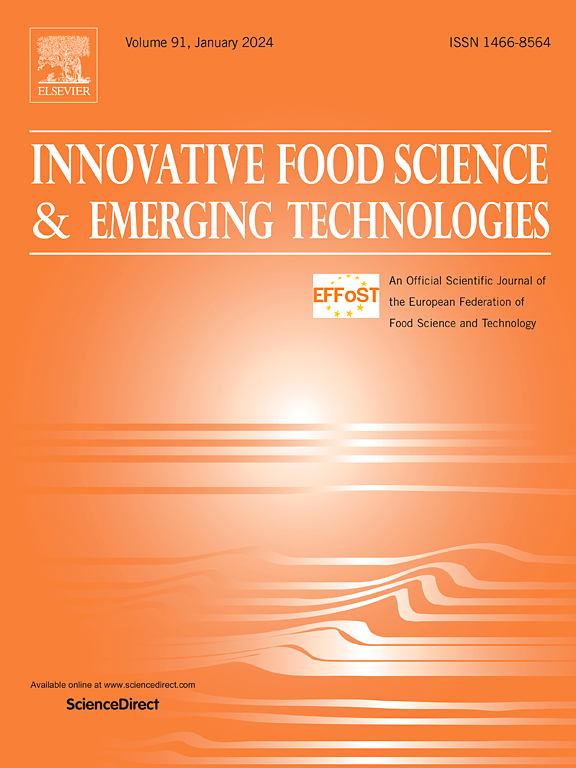Assessing the dry inactivation mechanism of polyphenol oxidase (PPO) and peroxidase (POD) employing catalytic infrared treatment based on experiments and molecular simulations
IF 6.3
1区 农林科学
Q1 FOOD SCIENCE & TECHNOLOGY
Innovative Food Science & Emerging Technologies
Pub Date : 2025-02-05
DOI:10.1016/j.ifset.2025.103943
引用次数: 0
Abstract
An innovative catalytic infrared (CIR) dry enzyme inactivation method was developed in this study to replace wet-heat methods. The residual activities and structural changes of peroxidase (POD) and polyphenol oxidase (PPO) after heat treatment were assessed experimentally. Molecular dynamics and docking studies were employed to compare the thermal and radiation effects of CIR. The results demonstrated complete inactivation (100 %) of PPO and POD after 65 min at 70 °C. This was attributed to both thermal and radiation effects of CIR, which disrupted hydrogen bonds, induced disordered secondary structure, loosened molecular conformation, encapsulated active sites, and reduced binding energy, thereby leading to enzyme inactivation. The thermal effect was more destructive to PPO and POD than the radiation effect, loosening by 1.81 % and 1.21 % of surface area, reducing by 0.87 % and 2.27 %, 2.85 % and 1.32 % of intra- and intermolecular hydrogen bond and 6.71 % and 4.21 % of binding energy, respectively. The mechanism of dry enzyme inactivation by CIR was elucidated. CIR is a promising alternative to wet-heat methods, offering energy savings and enhanced safety.
Industry relevance
Enzymatic browning, driven by polyphenol oxidase (PPO) and peroxidase (POD), is a significant concern in global fruit and vegetable processing. Conventional enzyme inactivation methods, such as wet-heat treatments, suffer from high energy and water consumption and contribute to environmental pollution. This increases processing costs and compromises product quality. In contrast, CIR is promising to be a new dry enzyme inactivation technology instead of wet-heat enzyme inactivation methods, which is energy-efficient, environmentally friendly, and capable of achieving optimal enzyme inactivation. This study conveys a better understanding of CIR mechanisms and optimal conditions of dry enzyme inactivation for its effective use in food processing applications on an industrial scale.
基于实验和分子模拟的催化红外处理研究了多酚氧化酶(PPO)和过氧化物酶(POD)的干失活机制
本研究提出了一种新型的催化红外(CIR)干酶失活方法,以取代湿热法。通过实验研究了热处理后过氧化物酶(POD)和多酚氧化酶(PPO)的残留活性和结构变化。通过分子动力学和对接研究比较了CIR的热效应和辐射效应,结果表明,在70°C下65 min后,PPO和POD完全失活(100%)。这是由于CIR的热效应和辐射效应,破坏了氢键,导致二级结构紊乱,分子构象松散,活性位点被包裹,结合能降低,从而导致酶失活。与辐射效应相比,热效应对PPO和POD的破坏更大,其表面积分别减少1.81%和1.21%,分子内和分子间氢键分别减少0.87%和2.27%,分子间氢键分别减少2.85%和1.32%,结合能分别减少6.71%和4.21%。阐明了CIR对干酶失活的作用机理。CIR是一种有前途的替代湿热方法,提供节能和提高安全性。由多酚氧化酶(PPO)和过氧化物酶(POD)驱动的酶促褐变是全球水果和蔬菜加工中的重要问题。传统的酶灭活方法,如湿热处理,存在高能耗、高水耗和环境污染的问题。这增加了加工成本,降低了产品质量。相比之下,CIR是一种新的干法酶失活技术,有望取代湿热酶失活方法,具有节能、环保、能实现最佳酶失活的特点。这项研究为CIR机理和干酶失活的最佳条件提供了更好的理解,从而使其在工业规模的食品加工应用中得到有效利用。
本文章由计算机程序翻译,如有差异,请以英文原文为准。
求助全文
约1分钟内获得全文
求助全文
来源期刊
CiteScore
12.00
自引率
6.10%
发文量
259
审稿时长
25 days
期刊介绍:
Innovative Food Science and Emerging Technologies (IFSET) aims to provide the highest quality original contributions and few, mainly upon invitation, reviews on and highly innovative developments in food science and emerging food process technologies. The significance of the results either for the science community or for industrial R&D groups must be specified. Papers submitted must be of highest scientific quality and only those advancing current scientific knowledge and understanding or with technical relevance will be considered.

 求助内容:
求助内容: 应助结果提醒方式:
应助结果提醒方式:


